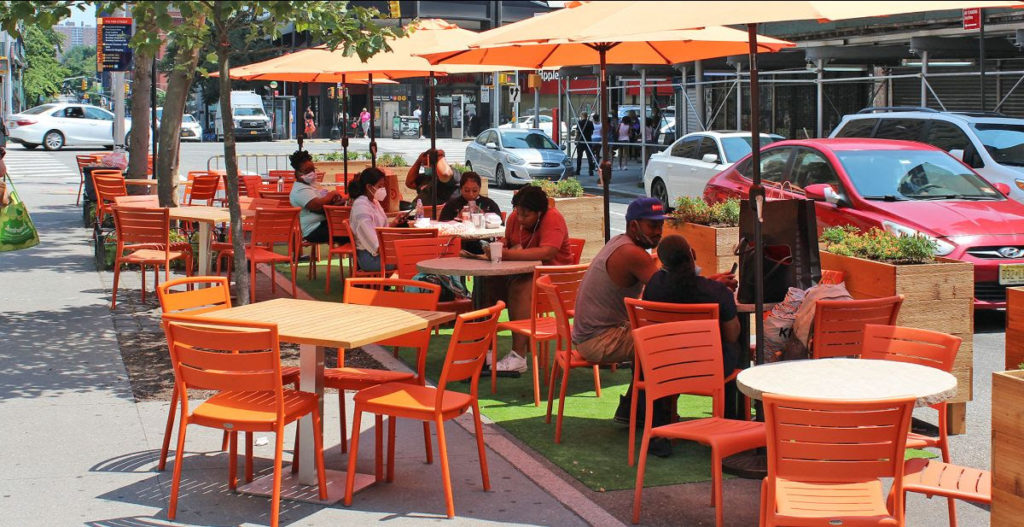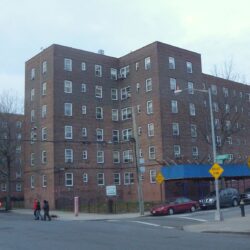An outdoor dining patio in Downtown Brooklyn. Photo courtesy of Downtown Brooklyn Partnership
Mayor Bill de Blasio, Council Speaker Corey Johnson and Department of Transportation (DOT) Commissioner Hank Gutman released on Wednesday the New York City Streets Plan to guide the development of bus, bicycle and pedestrian infrastructure over the next five years. This plan, which lays out ambitious goals and makes sweeping recommendations for future plans, will help New York City equitably deliver Vision Zero projects and ensure the safe, sustainable movement of people and goods.
“Vision Zero has shown the nation how to reimagine our streets for buses, bikes, and pedestrians – not just private vehicles. This plan charts a path forward to build on that progress with innovative ideas from the lessons we’ve learned. It will make our streets safer than ever,” said Mayor Bill de Blasio. “Thanks to the City Council’s important advocacy and DOT’s boundless energy and determination, New Yorkers have a thoughtful blueprint for the next era of street safety measures.”
“The piecemeal way we plan our streets held us back for far too long. New Yorkers paid the price every day stuck on slow buses or as pedestrians or cyclists on dangerous streets. I applaud DOT for all their work in making this new vision of a streets master plan a reality. This plan gives New Yorkers a concrete vision of how we will reshape the City over the next five years and work toward our goal of making this a safer and more equitable place to call home.” said Council Speaker Corey Johnson.
“This plan provides us the framework we need to target the next generation of street redesigns. It represents a draft that will help us deliver faster commutes for bus riders; safe bike lanes for cyclists; and sidewalks and curbs that are better managed for the changing demands of city living,” said DOT Commissioner Hank Gutman. “We thank Mayor de Blasio, the City Council and Speaker Corey Johnson for their leadership, guidance and vision in the creation of this plan.”
The de Blasio administration has built almost 70 miles of new bus lanes — nearly doubling the city’s network — and added another over 140 miles of protected bike lanes. This plan builds upon that work by identifying the next series of priority areas to redesign. DOT has created a new formula to determine where to prioritize improvements, identifying Priority Investment Areas that are based on equity, density, and previous levels of DOT investment. With a focus on equity, the DOT will ensure the Streets Plan benefits all New Yorkers fairly, bringing disadvantaged communities to the forefront of its planning process. This lens will help define areas of the city as priorities for improvements, along with previously established Vision Zero priority corridors.
The Streets Plan commits DOT to meeting the following benchmarks by Dec. 31, 2026:
- 150 Miles of physically or camera-protected bus lanes
- 4,750 Transit signal priority at intersections
- 250 Miles of protected bike lanes
- 2,500 Bus stop upgrades like benches, shelters, and real-time passenger information
- 2,000 Redesigning signalized intersections
- 2,500 Accessible pedestrian signals at intersections
- Assess and amend commercial loading zones and truck routes
- Develop parking policies to promote the master plan’s goals of safety, mass transit use, reduced vehicle emissions, and access for individuals with disabilities
- Create and maintain one million square feet of pedestrian space.
Community engagement will guide all of DOT’s street redesign projects, including vehicle, pedestrian, cyclist, and bus infrastructure. Beginning in 2023, DOT will detail progress toward these goals in annual updates. Two public feedback sessions will be held virtually on Dec. 14 and Dec. 16.
Some of the recommendations and transformative proposals from the Streets Plan include:
Freight
Innovating on the Movement of Goods: This plan, in conjunction with similar initiatives already underway at DOT, will reimagine how goods move to reduce our dependence on large, diesel trucks. We will look to better use the city’s waterways, rail, and smaller, greener alternatives. Equitable distribution of resources, street safety, and carbon footprint reduction will guide all efforts to build smarter freight management practices.
Traffic Safety & Vision Zero
Automated Enforcement: DOT will pursue New York State legislation to expand camera enforcement to include other dangerous driver behaviors, like blocking bike lanes, illegal turns, parking violations and even the presence of oversized trucks, among other illegal practices detailed in the report.
Cycling
Greenways and High-Capacity Protected Bike Lanes: DOT will develop new greenways that are physically separated from vehicular traffic and can serve as cycling highways across the city. These new greenways will complement ongoing efforts like the DOT’s Bike Boulevard program, which has helped build streets prioritizing bicycle and pedestrian traffic.
New Cycling Connections
DOT will identify locations with significant demand for new cycling/pedestrian bridges that could provide safer, more direct routes (such as Newtown Creek, Coney Island Creek, Hunters Point/Roosevelt Island), and initiate concept design studies. DOT will also explore introducing more high-capacity bikeways on our major bridges, as was just implemented on the Brooklyn Bridge, and coordinate with MTA to add or improve pedestrian and cycling accommodation on MTA bridges.
Curbside Management & Parking
Prioritize parking efficiency: DOT plans to increase meter parking in some of the densest parts of the city, with different prices for certain vehicles, to free up space for deliveries and other curb uses.
Sustainability & Resilience
Mitigating Urban Highways: DOT will prioritize community planning to develop redesigns to the City’s highway system that are either underutilized or have negatively impacted the health of surrounding residents, similar to Sheridan Blvd. The DOT has already committed $2 million to study the negative impacts of the Cross-Bronx Expressway and possible improvements.
“As more and more people decide to take alternative modes of transportation to get to their destinations, we need to set up all the proper safety measures to ensure pedestrians and cyclists are kept out of harm’s way,” said Council Member Ydanis Rodriguez, Chairman of the Transportation Committee. “I hope that as the City continues to redesign and reimagine the City’s streetscape, we must prioritize our immigrant, Black, Latino, and Asian communities who have been historically left behind. I look forward to continuing to work alongside Mayor de Blasio, Speaker Johnson, DOT Commissioner Gutman, and transportation advocates to ensure we are building a streets plan that prioritizes equity and the safety of all New Yorkers.”
“I am excited by today’s release of the New York City Streets Plan,” said Council Member Antonio Reynoso. “This plan offers a blueprint for how we can make New York City’s streets better reflect the needs of all New Yorkers, while also providing a framework for how we can ensure that equity will be at the center of every each and every redesign proposal. It is time to return our streets to the common good that they are, and the steps in this plan will help us do just that.”
“We were proud to be part of the advocacy that led to the NYC Streets Plan and we are very proud today of the expansive blueprint it has set forward for the future of our city. We are especially energized by many of the transformative ideas advanced, ranging from next-generation cycling greenways to disincentivizing deadly SUVs. Making this plan a reality will require continued focus, smart investment, and political will, and we are eager to partner with the Adams administration to put people first on our streets – especially in communities that have long been underserved. We thank the NYC DOT team for their many months of hard work in putting together this plan. These steps are how we can make streets a pathway to recovery and make a stronger, fairer, healthier city for generations to come,” said Danny Harris, Executive Director of Transportation Alternatives.
“Bus riders urgently need faster, more reliable commutes, which the mayor promised in the New York City Streets Plan. The plan out today from City Hall takes a reasoned, comprehensive approach and a meaningful step toward equitable streets. As required by law, the next administration must make much better buses a top priority. New York can’t claim to be the greatest city while millions of New Yorkers are forced to rely on the slowest buses in the United States,” said Riders Alliance Policy & Communications Director Danny Pearlstein.
“This is a much-needed, forward-looking plan that will transform the City’s streets and improve the daily experience for residents and commuters, with a focus on equity to prioritize communities that need these benefits the most. Transportation is the largest source of greenhouse gas emissions and New Yorkers need clean transportation options. From more walkable streets to safer bike infrastructure and more efficient bus lanes, the Mayor, City Council, and Speaker have demonstrated vision, leadership, and collaboration that will benefit our City for generations. We look forward to working with Mayor-elect Adams, NYC DOT and the Council to implement this plan on our streets efficiently and effectively,” said Julie Tighe, President of the New York League of Conservation Voters.
Leave a Comment





